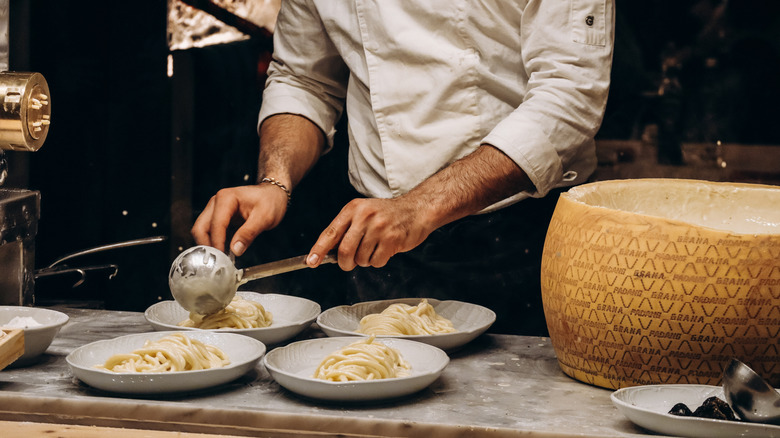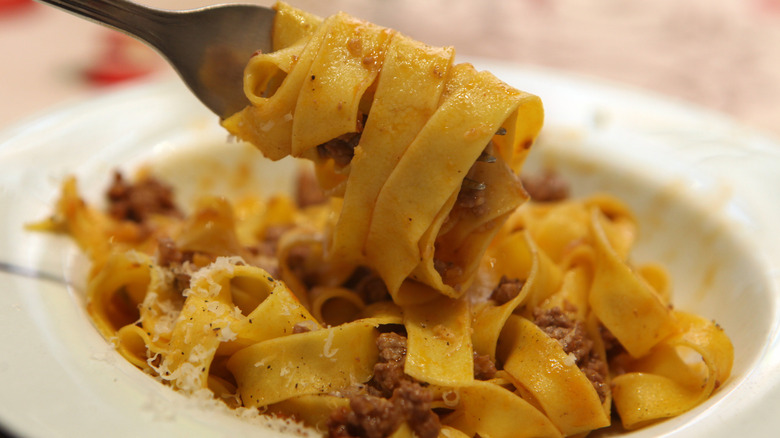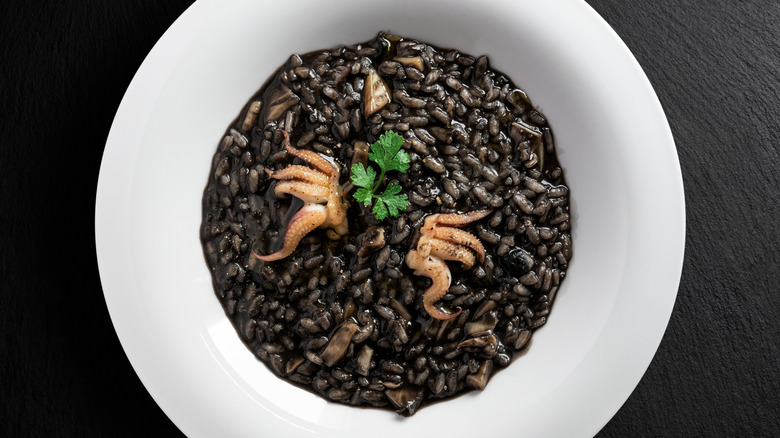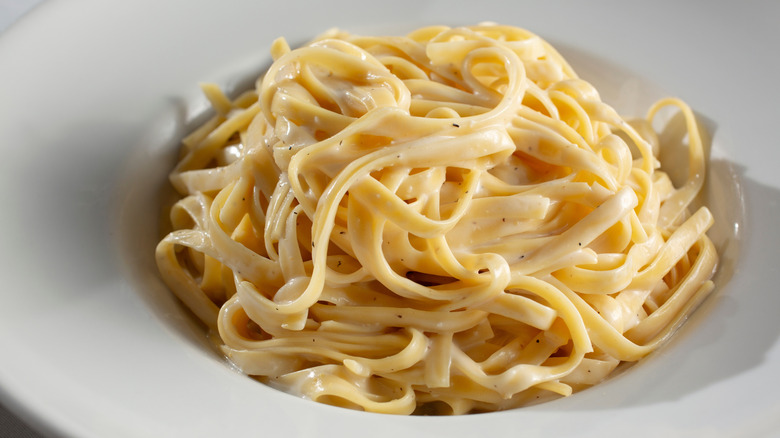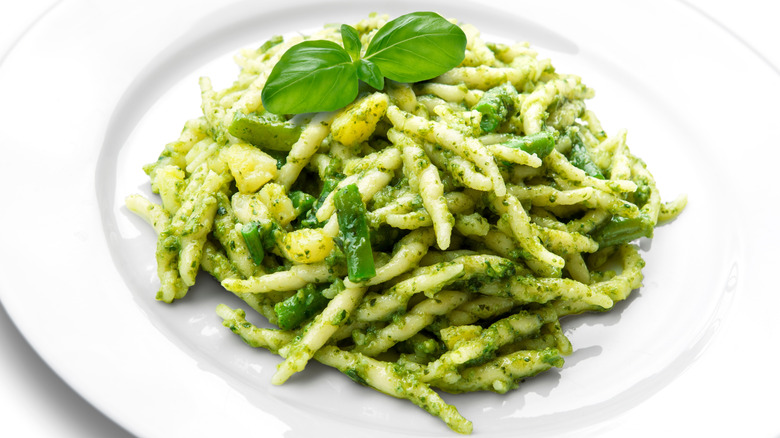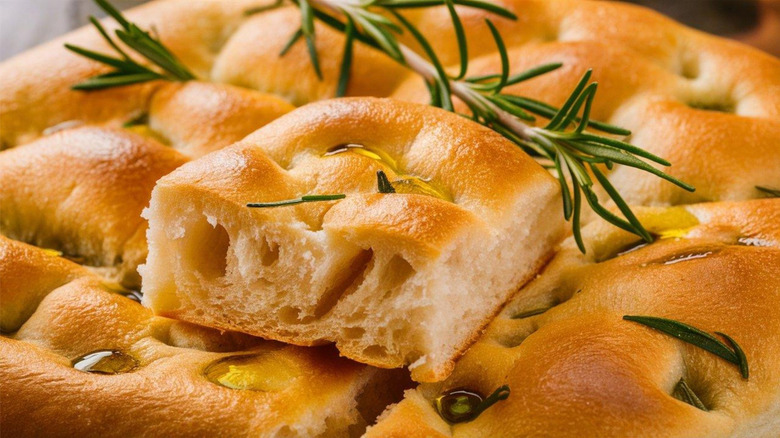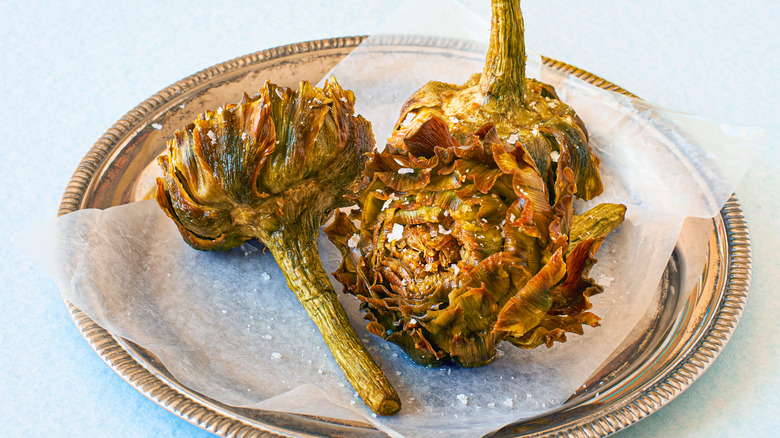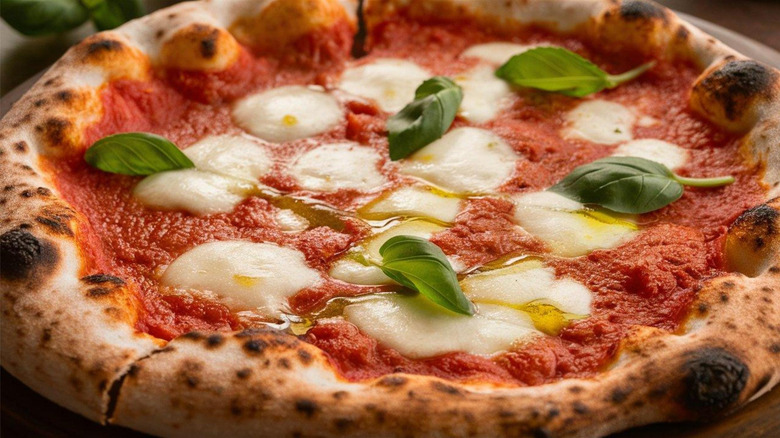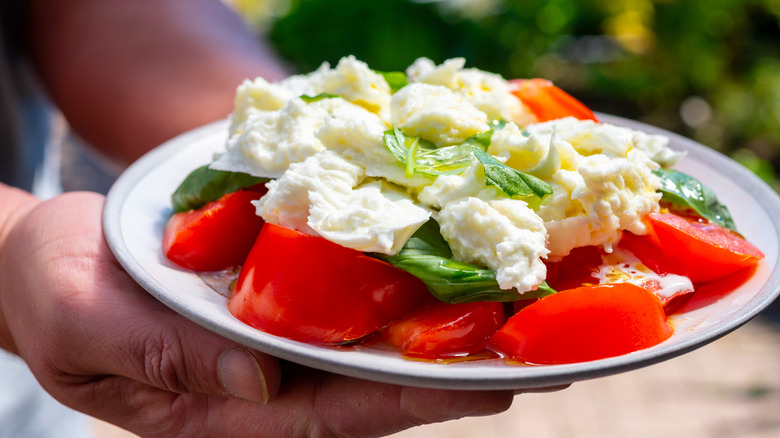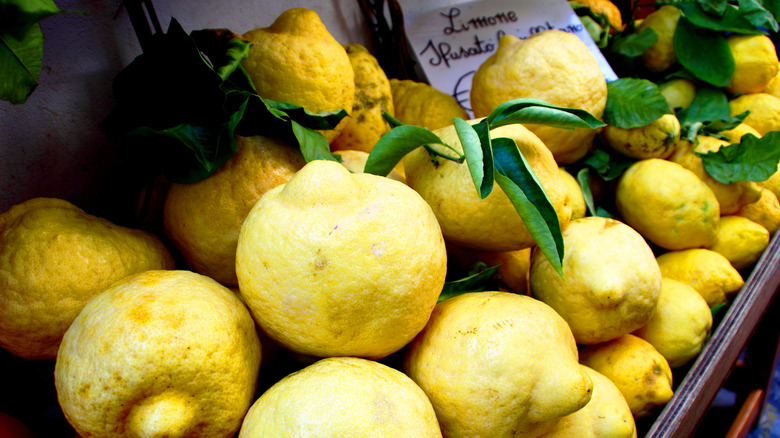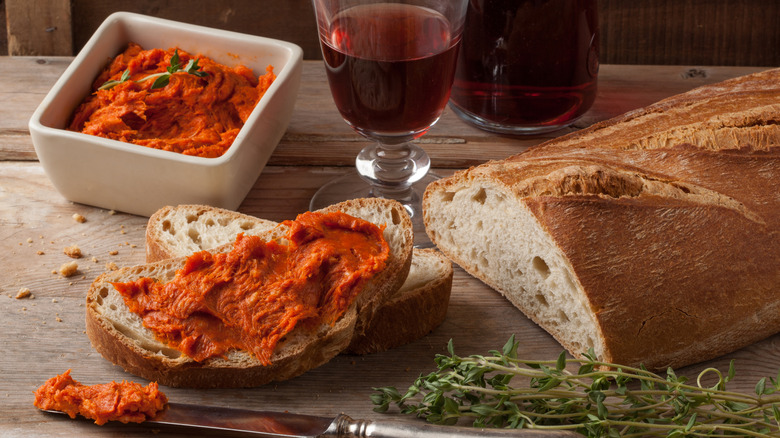13 Italian Dishes Everyone Should Eat Once In Their Life
They say there's two types of people in the world: Italians and those who wish they were. While this might be a slight exaggeration, there are few food lovers who don't have a soft spot for Italian cooking. Given that Italy has only been a unified country since 1861, its cuisine is rich in regional diversity. Couple this with its varied geography –– from the Alps to sunny Mediterranean islands closer to North Africa than to Rome –– and there's a lot of dishes to explore.
Millions of Italians emigrated to the United States in the 20th century, bringing their recipes with them. Some dishes have been adopted (and adapted) to become American staples, while other Italian dishes are harder to find locally or best eaten in situ on an Italian holiday. Here are 13 Italian dishes everyone should eat at least once in their life.
Ragù alla Bolognese: The original spaghetti Bolognese
All over Italy, slow-cooked meat sauces called ragùs are made; the best known comes from Bologna, capital of the region of Emilia-Romagna. Bologna's nickname is la grassa, la dotta, e la rossa –– the fat, the learned, and the red –– referring to its rich culinary tradition, its university that's the oldest in Europe (founded around 1088), and its distinctive red rooves.
Ragù alla Bolognese is the ancestor of America's beloved spaghetti Bolognese. Though in Emilia-Romagna Bolognese sauce would never be served with spaghetti, but with ribbons of fresh egg pasta such as fettuccine or pappardelle. The fresh pasta of central Italy uses 1 egg for every 100 grams of flour, making this dish even richer. Every Bolognese cook has their own secret recipe for the city's famous sauce — however, the Italian Academy of Cuisine added an "official" recipe" to their records in 1982, to ensure the authenticity of ragù alla Bolognese.
An important ingredient in most versions is milk to balance the acidity of the tomatoes. Time is another key element, as a good ragù must be simmered low and slow. When you visit Bologna, enjoy an authentic ragù Bolognese tossed through fettuccine or tortellini, or layered into lasagne verdi alla Bolognese made with sheets of spinach-tinted green lasagna.
Risotto al nero di seppia: Venetian squid ink risotto
While risotto is now popular throughout Italy, it originated in northern Italy where the climate is more suitable to growing rice than the hard durum wheat needed for southern Italy's dried pasta. Today every part of Italy makes risotto from local ingredients. Milan's risotto Milanese contains saffron and bone marrow, and in Emilia-Romagna they use wild porcini mushrooms. In Venice, risotto is colored and flavored with the ink of cuttlefish from the Venetian lagoon which, despite its striking color, has a subtle savory flavor.
While most Italian chefs favor carnaroli rice for risotto, in Venice vialone nano is used for the wetter, soupier-style risotto Venetians prefer. Although we typically refer to the black ink used to color risotto as "squid ink," it really comes from squid's close cousin, the cuttlefish.
Risotto must be eaten as soon as it's cooked, as the rice keeps absorbing moisture and becomes stodgy if left to sit. While some restaurants par-cook risotto for ease of service, serious Italian chefs cook it just before serving and so often require a minimum of two people to order it. Like pasta, authentic risotto is cooked "al dente," meaning it still has some resistance to the bite. At least once in your life, eat an authentic risotto al nero cooked to order in Venice and experience the difference.
Fettuccine Alfredo: An Italian-American classic thanks to Hollywood
Did you know that one of America's most loved pasta dishes was introduced to the United States from Rome by two Hollywood actors? Or that the original fettuccine Alfredo does not contain cream? Italian fettuccine Alfredo is dressed with a sauce made from just butter, cheese, and lots of pasta cooking water.
Many Italian chefs call the starch-rich water that pasta has been cooked in the "secret sauce." In Italy, cooked pasta is generally tossed in the pan with the sauce until every strand is completely coated. Adding pasta cooking water during this tossing helps emulsify the sauce, giving it a lovely creamy sheen without any cream.
Fettuccine Alfredo is named for Roman restaurateur Alfredo di Lelio, whose restaurant was a favorite with actors Douglas Fairbanks and Mary Pickford honeymooning in Rome in 1920. They brought fettuccine Alfredo back to America where, without rich Italian butter, authentic Parmigiano, and perhaps Italian know-how, they added cream to replicate the richness of the dish they'd enjoyed in Rome.
Today there are two types of fettuccine Alfredo: the Italian and the American. Both are delicious, but at least once in your life you should try the Italian version, ideally at Il Vero Alfredo in Rome run by Alfredo di Lelio's grandchildren.
Trofie al pesto Genovese: Ligurian pasta, potato, and green beans with basil pesto
While any sauce made from pounded ingredients can be called a pesto (the name means "pounded" in Italian), the best known is pesto alla Genovese from the Ligurian port of Genoa. It was traditionally made to preserve the bright flavor of summer basil year-round and for long sea voyages.
In Liguria, the classic way to enjoy pesto is with little twists of pasta, called trofie, cooked with string beans and diced potato all in the same water then tossed together in a bowl with the vivid pesto. Pesto is always served "al crudo" meaning it's never heated, so the pasta is added to the cold sauce off the heat to ensure the delicate flavors aren't lost.
Testaroli is another Ligurian dish often dressed with basil pesto. It's an ancient dish from the historic region straddling the corner where modern-day Liguria, Tuscany, and Emilia-Romagna meet. It resembles a thick pancake or flatbread, that's cut into diamonds, boiled like pasta, and dressed with a simple sauce, most often pesto alla Genovese.
Focaccia: Central Italy's answer to pizza
While many flattish, white breads pass themselves off as "focaccia," authentic Italian focaccia comes from Tuscany and Liguria and is made with a very generous amount of the local delicate olive oil. True focaccia is relatively flat, no more than an inch or two high, has an open texture, dimpled top, and is almost dripping with oil.
This versatile bread is great as a starter with some olives, a little more olive oil for dipping, and a glass of Italian white wine. Called Liguria and Tuscany's answer to pizza, focaccia also lends itself to an infinite array of topping or fillings. Once you master a basic focaccia recipe you can experiment with toppings, from basics like potato, onion, olives, or rosemary, to more complex combinations like layering Taleggio and pancetta in the middle of the uncooked dough for a delicious "stuffed crust" effect.
Carciofi alla Giudia: Roman Jewish-style artichokes
Rome has had a significant Jewish population since before the time of Christ and "Jewish-style artichokes," as the name of this dish translates, are a traditional part of the local Jewish cuisine now enjoyed by most Romans. Carciofi alla Giudia is one of the simplest vegetable dishes, consisting of whole fresh artichokes deep-fried in olive oil.
Until you've tasted them, it's hard to believe how delicious something as simple as deep-fried artichokes, with a good sprinkling of salt and squeeze of lemon juice, can be. Artichokes, the flower of a thistle, open up when deep-fried, and part of the joy of carciofi alla Giudia is the ritual of eating them petal by petal. The base of each petal is tender, and the edges are crisp and crunchy.
Once you've eaten every petal, there's the tender heart and juicy stem to enjoy. At least once in your life, feast on a Jewish-style artichoke, preferably in Rome's historic ghetto district or one of the many trattorias just across the river in Trastevere, such as Osteria la Gensola.
Pizza Margherita: Authentic Neapolitan pizza
Pizza originated in the port city of Naples as street food, a slice of which could easily be folded in half and eaten while strolling along. Of all Italy's many pizza styles and flavors, only Pizza Napoletana is protected by a certified appellation. Its TSG (Traditional Speciality Guaranteed) appellation, granted by the European Union, protects its name and specifies its ingredients and preparation method. A few variations are permitted under the rules, one of which is pizza Margherita.
Far less topping is used on Italian pizzas than on their American cousins. The only permitted ingredients for pizza Margherita are San Marzano tomatoes, grown in the rich volcanic soil of nearby Mount Vesuvius; authentic buffalo mozzarella (traditional to the Campania plains near Naples); fresh basil, and extra virgin olive oil. The red, green, and white of pizza Margherita echoes the colors of the Italian flag.
Authentic pizza Margherita must have the thin base and fluffy, slightly raised, edges that are traditional to all Neapolitan pizza, and be cooked in a wood-fired oven. Pizza Margherita is a dish best enjoyed in Naples, if possible, at least once in your life.
Insalata Caprese: A plate of summer from the Isle of Capri
Insalata Caprese is a classic Italian mozzarella and tomato salad from the Isle of Capri in the Bay of Naples. Like all simple dishes it relies on the quality of its ingredients to be truly delicious. Insalata Caprese made with rubbery, tasteless cow's milk bocconcini or fior di latte mozzarella is a waste of time.
Somewhere between the 6th and 8th century AD, water buffalo were brought to the swampy plains around Naples to be used as draft animals. Today this area is home to Mozzarella di Bufala, one of Italy's most delicious cheeses. True insalata Caprese consists of soft, slightly oozy, buffalo milk mozzarella with its sweet lactic tang; super ripe tomatoes; aromatic basil leaves; a sprinkle of salt; and a generous drizzle of extra virgin olive oil. No more and no less, otherwise it isn't worth eating.
Insalata Caprese is a perfect appetizer or topping for bruschetta, while gnocchi alla Sorrentina, made by tossing the same ingredients with potato gnocchi, is traditional to the nearby town of Sorrento. Provided you can get good buffalo mozzarella and ripe tomatoes, insalata Caprese is a summer dish you can enjoy anywhere — and if you happen to be eating it on Capri, amazing.
Mozzarella grilled in lemon leaves: An Amalfi specialty
The Amalfi Coast is famous for its enormous, knobby, thick-skinned sfusato lemons, used in everything from limoncello and cakes to pasta sauce and gelato. Typical of peasant cuisine, nothing is wasted, and the leaves of the lemon trees are also used to flavor local scamorza cheese, a firm, semi-aged mozzarella.
Mozzarella grilled in lemon leaves is a dish worth seeking out if you're holidaying on the Amalfi Coast, but any semi-soft cheese, such as haloumi, is delicious grilled between lemon leaves. This is a very easy dish to make if you, or a neighbor, have a lemon tree in the garden. Trim slices of cheese so they can be sandwiched between two large lemon leaves and secured with toothpicks, then cook on a barbecue or in a char-grill pan for a minute on each side. Depending on the texture of the cheese it may ooze out a little, but that doesn't matter as those crusty bits are delicious scraped off the grill. This is a dish best eaten with your hands. The leaves aren't eaten, just use some crusty bread to scrape the cheese off them.
La ribollita: Tuscan bread, cabbage, and bean soup
You know that an Italian dish is held in high esteem when its name is preceded by the definite article "la" or "il" — and in this case making it not just ribollita but "the ribollita." This Tuscan soup is a classic example of cucina povera (peasant cooking). The name literally means "the reboiled" as la ribollita was a way to use up excess beans and vegetables from Friday when no meat was eaten in Catholic Italy. On Saturday, the leftover vegetables were traditionally turned into soup, made even more filling by adding stale bread.
There are as many versions of ribollita as there are Tuscan cooks. All contain stale bread, Tuscan cabbage (cavolo nero in Italian), and beans (usually cannellini though sometimes borlotti), plus whatever seasonal vegetables are on hand. Sometimes ribollita is finished in the oven so the bread crisps up a little on top, and almost everyone serves it drizzled with delicate Tuscan olive oil.
Ice cream or strawberries with balsamic vinegar: Dessert made in heaven
Can you really put vinegar on ice cream and strawberries? Absolutely, if it's the traditional balsamic vinegar of Modena: Aceto Balsamico Tradizionale di Modena. Despite having bought many bottles with the words "balsamic" and "vinegar" on them, it's quite possible you've never tasted authentic traditional balsamic vinegar. Even if you have, your taste buds haven't lived until you've had an extra vecchio (25 year old) balsamic vinegar drizzled over good vanilla bean ice cream.
Authentic balsamic vinegar is a sweet-sour elixir produced solely from the cooked must of crushed grapes aged in a series of barrels, each made from a different wood including chestnut, cherry, and juniper. The resulting vinegar is fractionally blended so the minimum age of the liquid in each bottle is either 12 years (white cap) or 25 years (gold cap). Because of the fractional blending however, every bottle also contains some much older vinegar, going back to when the barrel was first filled.
Such traditional balsamic vinegar is only available in 100 milliliter bottles and is only made in two parts of Emilia-Romagna: Modena and Reggio Emilia. At least once in your life, taste it drizzled over vanilla ice cream or ripe strawberries. It's also wonderful on fresh figs, cheese-filled ravioli, cheeses such as stracciatella, mozzarella, or Parmigiano, and ripe tomatoes.
'Nduja: Calabria's fiery spreadable salami
'Nduja (pronounced en-DOO-yah) is a fiery, spreadable salami from the southern Italian region of Calabria. It's an ingredient as well as a dish in its own right spread on bread, crackers, or croutons. If you're a chili-head, once you've discovered it, you'll certainly be back for more.
Originally made from scraps of meat leftover after a pig was butchered, 'nduja contains a lot of pork fat with some pork meat and dried red chilies. The quantity of fat gives it a spreadable consistency, like sausage mince or a thick pâté, and the chili colors it a deep brick red.
'Nduja is versatile and typically served as an antipasto on bread or with mild cheeses; tossed through pasta; stirred into sauces, casseroles, or soups; or added to just about anything that can do with a little porky heat to amp up its flavor.
Bottarga di muggine: Salty Sardinian amber
Bottarga di muggine is made from the roe sacs of grey mullets that have been salted, pressed, and air-dried. Different types of bottarga, including tuna, have been made throughout the Mediterranean since ancient times. Nowhere is it more popular than on the Italian island of Sardinia, where bottarga di muggine is a favorite seasoning. Traditionally, Sardinians lived inland, away from the coast that was prone to pirate raids, so their seafood had to be preserved.
The whole roe sacs prepared as bottarga look like flat orange sausages; once sliced, they almost resemble amber. At its simplest, slices of bottarga drizzled with olive oil are an excellent antipasto, often served with raw vegetables such as celery and artichoke, and Sardinia's traditional flatbread, pane carasau (carta di musica). In Sardinia, bottarga is used in many dishes: shaved over salads, grated over pasta, and beaten into butter to melt onto steak, seafood, or vegetables. Bottarga is a rich, salty umami flavor bomb that everyone should try at least once in their life.

